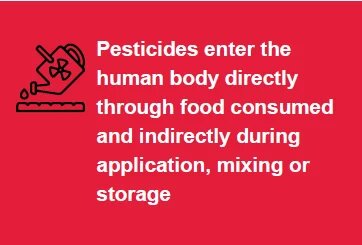
Regulating pesticide registration and labelling is not enough; close monitoring on the ground is critical. In Kenya, this is where the food safety chain begins to break.

The government closely regulates how substances such as alcohol, cigarettes and drugs are used, sold and marketed. Alcohol advertisements must specify that the product is “not for sale to persons under 18 years” and cigarette packets carry mandatory health warnings. The Pharmacy and Poisons Board, the regulatory body in charge of medical drugs, may withdraw a drug if there are safety concerns, or if it does not meet market authorization thresholds.
Pesticides are drugs, for all intents and purposes. The difference is that they act on plants and not humans –managing or killing weeds, pests and diseases caused by organisms like fungi. However, they can and often do find their way into human bodies, a reason for greater regulation. Pesticides enter the human body directly through food consumed and indirectly during application, mixing or storage. Other ingestion routes include contaminated water or when pesticide residues travel up the food chain through fish/aquatic animals or bees into honey.
It is a matter for concern when pesticides cross into humans or the environment. This is because they act outside of their intended organisms, leading to side effects, some of which can be potentially harmful. In humans, they can lead to reproductive toxicity, cause harm to unborn children, damage genetic material or cause mutation, which may lead to cancer. In the environment, these drugs can affect bees and kill marine life, beneficial insects, and birds.
Theoretically, pesticide use within stipulated application and pre-harvest guidelines should be relatively safe. And there are dozens of regulations concerning the manufacture, registration, marketing, use and application of pesticides, both locally and internationally. However, there is a mismatch between intent and the reality on the ground.
Like drugs, pesticides are subject to strict regulations to minimize or prevent toxic effects on humans or the environment. The World Health Organization (WHO) and the Food and Agricultural Organization (FAO) provide guidelines on labelling, application and monitoring of pesticides, and even on their marketing and advertising. Individual countries customize the FAO/WHO guidelines to develop regulations to suit their contexts.
Pesticide Regulations in Kenya
The Pest Control Products Board (PCPB) is the government body that regulates pesticides. The PCPB website provides a list of registered, banned or restricted use products, and lists of the premises licensed to sell pest control products as well as the various relevant acts, regulations and notices.
The PCPB classifies pest control products under four categories: Restricted, Commercial, Agricultural, and Domestic. The Restricted Class lists products that meet a specific oral, dermal or environmental toxicity threshold, along with limitations to their distribution and use, and the qualifications of those allowed to apply them.
The Commercial and Agricultural categories list pesticides whose toxicity threshold is much lower than that of the Restricted Class and their use and distribution are also stipulated. The pesticides in the Domestic category have a much lower toxicity threshold and are considered safe for household use, without special precautions or equipment specified. The packaging is in such sizes that the amounts can be safely used and stored at home.
Reality on the Ground
Regulating pesticide registration and labelling is not enough; close monitoring on the ground is critical. In Kenya, this is where the food safety chain begins to break.
The International Code of Conduct on Pesticide Management recommends buffer zones and strict preharvest intervals when using highly hazardous pesticides (HHPs). However, most farms are too small and some are located next to residential areas, schools and hospitals, rendering the establishment of buffer zones difficult.
Moreover, pesticides are sold to untrained farmers; only 1 in 6 farmers can read labels according to a recent Route to Food report. Pesticides classified in the Restricted, Agriculture, and Commercial categories and requiring certain qualifications/training to use end up being handled like those in the Domestic category – applied without the mandatory personal protective equipment (only 1 in 6 farmers wear protective gear), without any training, and under poor storage and disposal conditions.
The FAO recommends an incident reporting system where emerging problems with pesticide formulation or use can be tracked, recorded and the data used in decision-making. This is an example of the kind of feedback loop that is required to connect policy on paper and practice on the ground, yet this approach does not seem to be used in Kenya where pesticide poisoning is a growing concern in public health. According to one study, up to 52% of acute poisonings in agricultural zones are caused by pesticides. In addition, numerous reports have shown residues of toxic pesticides above the tolerated maximum residue limits (MRL) in market produce, yet this feedback is not taken to rectify the policy on paper further disconnecting policy and practice.
Market Surveillance, Traceability and Food Safety
Various government agencies monitor produce at different levels of the value chain. The Kenya Plant Health Inspectorate Service (KEPHIS) monitors plant health, including seeds and seedlings, and certifies import and export produce, ensuring that phytosanitary requirements for export produce are met. Under the Agriculture and Food Authority, the Horticultural Crops Directorate (HCD) regulates the horticultural sector, monitoring compliance of horticultural produce and enforcing standards through
inspection and surveillance in aggregation and market centres. The Department of Veterinary Services monitors animal health drugs and pesticide residues in feed and animal products. The National Biosafety Authority supervises the handling of genetically modified/engineered organisms. The Kenya Bureau of Standards (KEBS) comes in at the tail end of consumer-ready foods to provide standards and examine microbial and chemical contamination in food. Through the Department of Health, the Ministry of Health exercises its mandate at different points; for example, at the consumer end to ensure hygiene standards in eateries and restaurants.
The Food and Feed Safety Control Coordination Bill, 2023
Despite the many agencies and their mandates, regulations and standards in the country are poorly harmonized. The parliamentary Agricultural Committee on Food and Feed Safety acknowledges that Kenya lacks a functional food safety surveillance system and that the multiple agencies can hinder progress where there are overlapping mandates.
Thus, the Food and Feed Safety Control Coordination Bill 2023 currently before parliament aims to address some of these issues. The Bill proposes the setting up of institutions such as the Office of the Food Safety Controller, and the assigning of roles for counties in the implementation
and enforcement of food and feed safety measures. The roles of the Agriculture and Food Authority, KEPHIS and PCPB are expanded to include conducting audits of the established traceability mechanisms. If the Bill is passed, the Office of the Food Safety Controller could harmonize all the bodies, agencies and regulations involved. But whether the Office will have the resources, capacities and political will to exercise this mandate is another matter.
Way Forward
The local produce market lacks the human resource capacities, the regulatory frameworks and the close linkage between the farmer, the dealers and the market. There are, therefore, lessons to be learned from the export produce market where small-scale producers are organized into groups and advised on pesticide use. Regular training, monitoring and testing ensure compliance. Collection and aggregation are implemented in such a way that produce can be traced back to the farmer, making it easier for dealers to identify the origin of any unfit produce.
Most of our food production – up to 70% - is by smallholder farmers who have room to utilise multiple sets of tools in pest management: crop rotation, good agricultural practices and integrated pest Management; biopesticides; chemical pesticides. However, the prevailing approach is the use of highly hazardous pesticides without considering the threat of pests developing resistance. Globally, just like antibiotics in the medical field, fewer new pesticides are released each year due to the high costs of research and testing. With every new case of resistance, we face the risk of running out of pesticides.
It has to be noted that most of the highly hazardous pesticides were designed for use in high-income countries where farming is intensive and large-scale, where fewer people work in agriculture – typically 6 to 7% of the population compared to 60 to 70% in low-income countries such as Kenya – and where training capacities and resources to ensure compliance and implement surveillance and monitoring are available.
Balancing Safety and Need
Safety and the need for pesticides is a constantly shifting balance that regulators need to strike. For example, in 2016, the FAO published Guidelines on Highly Hazardous Pesticides that proposed three measures for mitigating the risks of HHPs: ending their use; selecting products with the lowest risks to human health and to the environment; changing formulations and packaging in order to ensure their proper use.
However, there are other different ways to go about achieving the safety versus need balance. For example, where more toxic pesticides need to be used in the interest of food security, a phased approach can be considered in which they are used early in the growing phase while less toxic pesticides are applied towards the late growing/harvest period.
Additionally, the PCPB is mandated to issue temporary or emergency registration where necessary, for example, during an outbreak of a disease or pest that cannot be managed by any other means.
Dynamic Regulation and Feedback Loops
Lastly, a dynamic rather than a static approach is more suitable in the regulation of plant and livestock drugs. This is of particular importance where there exist capacity or resource gaps with regard to compliance with safety or testing guidelines. Data from market surveillance can be used as feedback to inform regulation and make adjustments as the market conditions change.
Regulation can and should also be reactive, informed by emerging problems in the market. If a pesticide is registered and it is later found out that it is not being correctly used, and there are emerging risks to consumers, the regulations concerning the pesticide should be revisited and rectified. The Pharmacy and Poisons Board has such a system in place, a post-market surveillance mechanism that keeps track of emerging problems with products or their use once in the market and adjusts regulations to safeguard public health.
The Constitution of Kenya 2010 provides that Kenyans have a right to be free from hunger, and to have adequate food of acceptable quality. For that quality to be guaranteed, food safety regulators must strive to ensure that harmful pesticides do not make their way up the food chain and into our bodies.
This article was extracted from Cha kula Magazine, Issue 7. The issue is available for download here.
